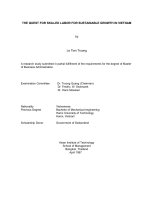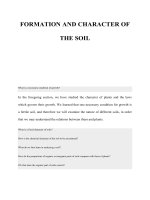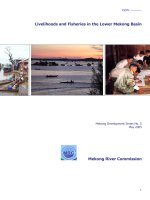Eco biology and fisheries of the whelk, babylo
Bạn đang xem bản rút gọn của tài liệu. Xem và tải ngay bản đầy đủ của tài liệu tại đây (7.5 MB, 198 trang )
ECO-BIOLOGY AND FISHERIES OF THE WHELK,
BABYLONIA SPIRATA (LINNAEUS, 1758) AND
BABYLONIA ZEYLANICA (BRUGUIERE, 1789)
ALONG KERALA COAST, INDIA
Thesis submitted to Cochin University of Science and Technology in
partial fulfillment of the requirement for the degree of
Doctor of Philosophy
Under the faculty of Marine Sciences
By
ANJANA MOHAN
(Reg. No: 2583)
CENTRAL MARINE FISHERIES RESEARCH INSTITUTE
Indian Council of Agricultural Research
KOCHI 682 018
JUNE 2007
®edi'catec[ to My
Tarents. . .
Certificate
This is to certify that this thesis entitled “Eco-biology and fisheries of
the whelk, Babylonia spirata (Linnaeus, 1758) and Babylonia zeylanica
(Bruguiere, 1789) along Kerala coast, India” is an authentic record of research
work carried out by Anjana Mohan (Reg.No. 2583) under my guidance and
supervision in Central Marine Fisheries Research Institute, in partial fulfillment
\
of the requirement for the Ph.D degree in Marine science of the Cochin
University of Science and Technology and no part of this has previously formed
the basis for the award of any degree in any University.
Dr. V. ipa
(Supervising guide)
Sr. Scientist, Mariculture Division
Central Marine Fisheries Research Institute.
Date: 3?-95' LN?‘
Declaration
I hereby declare that the thesis entitled “Eco-biology and fisheries of the
whelk, Babylonia spirata (Linnaeus, 1758) and Babylonia zeylanica (Bruguiere,
1789) along Kerala coast, India” is an authentic record of research work carried
out by me under the guidance and supervision of Dr. V. Kripa, Sr. Scientist,
Mariculture Division, Central Marine Fisheries Research Institute, in partial
fulfillment for the Ph.D degree in Marine science of the Cochin University of
Science and Technology and no part thereof has been previously formed the basis
for the award of any degree in any University.
(ANJAN A MOHAN)
Date: 2.7» 05- 07
Acknowledgement
I am greatly indebted to Dr. V. Kripa
(supervising guide), Sr. Scientist, Mariculture
Division, Research Center of CMFRI, Calicut for her
guidance, valuable suggestions, constant
encouragement, criticism and support during the course
of my investigation and documentation.
I owe many thanks to Dr. Mohan Joseph Modayil,
Director, CMFRI, Kochi for extending all the
facilities for successful completion of this research
work.
I express my deep sense of gratitude to Dr. K.
Sunilkumar Mohamed, HOD, Molluscan Division, CMFRI for
his constant help, guidance, subjective criticism and
encouragement in preparing the thesis.
It is my pleasure to acknowledge Dr. K.K.
Appukuttan, former HOD anui Principal Scientist,
Molluscan Fisheries Division of CMFRI for helping me
carry out my work and in the preparation of the
manuscript.
I acknowledge my deepest sense of gratitude to
Dr. M. Srinath, HOD, FRAD, Dr. T.S. Velayudhan,
Principal Scientist, Dr. P. Laxmilatha, Senior
Scientist; Dr. Shoji Joseph, Senior Scientist; Dr.
Somy Kuriakose, Scientist Sr. Scale; for their help
during the course of my study.
I am highly indebted to Dr. Paul Raj, Scientist
in Charge, PGPM, CMFRI for the timely help in all
matters concerned with my Ph. D programme. The help
and support extended kqriflua PGPM staff':Ms gratefully
acknowledged.
I wish to express my sincere thanks to time OIC
library and other staff members" for the help and
cooperation extended.
I am thankful to Dr. Sarala Devi, Scientist, Mrs.
Jasmine, Dr. Jayaraj, Research scholars, NIO, Kochi
for their help rendered to me during the tenure of
work.
I zmn grateful to [hm P. PL Radhakrishnan,
i
the manuscript. I also thank other staff members of
Calicut RC of CMFRI for their help.
I thank Shri P. Radhakrsihan, Shri. Mathew
Joseph, Shri. P.S. Alloycious, Smt. Jenny Sharma,
Shri. M.N. Sathyan, Smt N. Ambika, Mrs. Sheela, Shri.
Zainudeen, Shri. Jeevanraj staff of Molluscan
Fisheries Division, CMFRI for their great help and
constant encouragement in carrying out my work.
My special thanks are due ix) Mr. Ramalinga, Dr.
R. Gireesh, Mr. P. S. Sivaprasad, Dr. S. Balu, Mr. M.
Vinod, Dr. K.P. Abdu Rahiman, Dr. Satish Sahayak, Dr.
Anikumari, Mrs. Sreejaya, Mrs. Leena Ravi, Mrs. R.
Jugnu, IMiss. ‘Neetha. Susan David, lflr. PL Hashinl and
other Senior Research Fellows of CMFRI, Kochi for
their timely help auui constant encouragements during
the course of my study.
I greatly acknowledge the financial assistance
from tfluz AP Cess fund. of Indian Council of
Agricultural Research in the form of Senior Research
Fellowship under the project “Development of
seafarming techniques for commercially important
whelk, Babylonia spp.”.
I thank Mr. Shaji, Mr. Marshal Mr. Lknz and all
those who have helped me collecting the samples.
Above all, I am greatly obliged to my parents and
family for their kdessings and encouragement without
which the completion of this work would only have been
a dream.
Anjana Mohan
H
Contents
Acknowledgement
1-11
Chapter 1. Introduction
l
Chapter 2. Review of literature
2.1 Eco-biology of gastropods
2.2
2.3
2.4
2.5
Fishery
Utilization
8
18
By—catch
23
24
Management
26
Chapter 3. Materials and methods
3.1
Sampling
3.2 Analysis
28
30
Chapter 4. Results
4.1 Hydrology
Sediment characteristics
Whelk distribution and abundance
Associated Fauna
Relationship of whelk abundance with
abiotic and biotic factors
4.6 Reproductive biology
4.7 Food and feeding
4.8 Biometric relationships
4.9 Length frequency distribution
4.10 Mean length
4.11 Growth
4.12 Fishery
4.2
4.3
4.4
4.5
40
46
49
52
75
77
87
88
91
95
97
101
Chapter 5. Discussion
ll-4
Chapter 6. Summary
145
References
149
Cfiapter 1
Introduction
1. Introduction
Molluscs form one of the earliest recorded groups of living organisms. Their
presence on planet earth since the Paleozoic era 540 million years ago has been
proved beyond doubt. Abundance, size and diversity and their dual roles as predators
and prey make molluscs an indispensable component of tropical marine ecosystems.
With more than 80,000 species, the phylum Mollusca is second only to the phylum
Arthropoda. Of these, only about 28 species of bivalves and 65 species of gastropods
are of commercial importance either in shell trade or for edible purpose and 14
species of cephalopods are exploited commercially. Although only a few reliable
comparative data exist, molluscs probably comprise 15-40% numerically of benthic
macro invertebrates and are exceeded only by polychaetes and crustaceans in tropical
lndo-West Pacific coastal marine environments (Longhurst and Pauly, 1987).
Species of the class Gastropoda of phylum Mollusca with their omamental
shell and succulent meat have been harvested since time immemorial. The
production has increased considerably from 30,499 tomies in 1950 to l,2l,657 t in
2003 (FAO, 2003). The peak during the period 1950 to 2003 has been in 1996, when
1,4 l ,780 t were harvested from the natural beds. During the past 25 years the number
of countries involved in gastropod fishing rose from 23 to 47. (Leiva and Castilla,
2002). The four major gastropod groups which contributed to world fisheries in 2003
were whelks (30.9%), stromboid conchs (19.5%), turbo snails (18.7%) and abalone
(10.3%). The dominant species were Buccinum undatum (31,492 t), Strombus spp.
(23,666 t), Turbo cornutus (22,721 t), Busycon spp. (6130 t), Haliotis rubra (5094 t)
Concholepas cocholepas (2857 t) and Murex spp. (2337 t). The three main producers
of gastropods are Europe (28.65%), North America (25.l3%) and Asia (23.23%).
The entire quantity of B. undatum fished is from Europe. Leiva and Castilla (2002)
reviewed the world gastropod fishery. They have stated that the gastropod fishery is
mainly from three regions, viz, (l) the American continent, where the muricid
commonly called “loco”, Concholepas concholepas is fished from Chile and Peru;
strombid conch, Strombus spp., from the Caribbean and the abalone, Halioris spp.,
l
from Califomia (2) the Asia and Oceania, with the well established abalone fishery,
mainly in Australia and New Zealand, and the horned turban snail, Turbo truncatus,
in Japan and Korea and (3) from Africa and Europe where, Haliotis midae is heavily
fished from South Africa, and the common periwinkle, Littorina littorea, and the
whelk Buccinum undatum from Europe. Globally six species of genus Babylonia are
commercially important, viz, Babylonia areolata, B. japonica, B. formosaeformosae,
B. formosae habei, B.spirata and B. zeylanica. These are very popular mainly in
Southeast Asian countries.
In several parts of the world due to high economic value and excessive
capture many marine gastropods show, or have shown serious problems of
overexploitation (Tegner, l989; Castilla, 1996; Ponce-Diaz et aI., 1998; Hobday et
a1., 2001). In many cases this has led to the collapse or permanent closure of the
fishery. The social and economic consequences of these collapses have promoted the
development of new management perspectives centered on both biological and
economical sustainability (Baker er al., 1996; Prince et al., 1998; Castilla, 1997a,
1999, 2000). One of the major gastropod fisheries which has collapsed due to
overexploitation is the Chilean muricid fishery. Between 1979 and 1988, Chile was
the most important marine gastropod extractor in the world, accounting for over 35%
of the world gastropod landings (1980). However, after 1989, the main Chilean
gastropod fishery, the muiicid gastropod Concholepas concholepas, declined most
likely due to stock over-exploitation (Castilla, 1995, l 997b; Castilla et al., 1998).
Another classic example of over-fishing is the Califomian multi-species abalone
fishery. In the last 150 years five abalone species: Haliotis corrugata (pink abalone),
H. fulgens (green abalone), H. rufescens (red abalone), H. sorenseni (white abalone),
and H. cracherodii (black abalone), have been commercially extracted in Califomia.
The overexploitation phase started in 1968 and in May 1997 the entire Californian
coast was closed to commercial abalone fishery. Hobday and Tegner (2000)
summarized the management history for the California abalone fishery, where several
regulatory extraction tools were implemented between 1901 and (I997: minimum size
limit, commercial permit fee, minimum commercial landing, recreational limit and
2
recreational and commercial gear regulation. In spite of these management tools, the
abalone populations in California continued to decline, until total closure was decreed
in 1997.
Leiva and Castilla (2002) have described the utilization of adaptive
management tools such as exclusive rights for fishing gastropods which are given to
small scale fishers associates (cooperation); Individual Transferable Quotas (ITQs)
and Total Allowable Commercial Catches (TACC). Apart from these novel
management adaptive tools, such as the implementation of the Benthic Regime for
Extraction and Processing (BREP), the introduction of Non-Transferable Individual
Quotas (NTIQs) and territorial use rights for benthic fisheries, such as the
Management and Exploitation Areas (MEAS) are also presented.
In addition to the targeted resources several other benthic invertebrates also
are landed in huge quantities and it has been observed that major share of this is also
several species of other gastropods. Leiva and Castilla (2002) have elaborated the
need for management plans based on biological, ecological surveys and have
considered that eco-biology is an indispensable component of benthic invertebrate
fisheries management.
In India, molluscs have occupied a marked place in the affairs of state and
economy of mind and aesthetic values, of religion and rites of worship (Mukundan,
1968). Evidence of long standing association between man and mollusc in India is
afforded by the shell remains discovered in human _ habitation of pre-vedic
Mohanjedaro, Harappa, Amri, Na], Nundara and Rupar. These included not only the
cowries (Cyprea) and chank (Xancus) but also their products — bangles and cores of
shells from which the bangles have been sawn out (Mukundan, 1968). From India, a
total of 3271 species of molluscs belonging to 220 families and 591 genera have been
documented and, of these 1900 are gastropods, 1100 bivalves, 2210 cephalopods, 4l
polyplacophorans and 20 scaphopods (Appukuttan, I996).
3
The southwest and southeast coasts and the coral reef ecosystem in the
Lakshadweep and Andaman and Nicobar Islands harbour some of the richest
gastropod beds along the Indian coast. One of the earliest records of research on
ecology and distribution of molluscs is that of Homell (1922), who gave an
evaluation of the faunistic condition and topographical features of the chank beds of
Gulf of Mannar with hypothetical diagrams. Later, Mahadevan and Nayar (I976)
made extensive underwater surveys using SCUBA (Self Contained Underwater
Breathing Apparatus) during the period 1962-66 and again for a couple of years from
I968. Subsequent to this, the CMFRI has conducted research and development
programmes related to gastropods, including the distribution and abundance of
molluscs in the Andaman and Nicobar Islands (CMFRI, 1983) and the Lakshadweep
Island (CMFRI, 1989). Several species of gastropods are fished and their shell is
used for making exquisite pieces of handicrafts. Such shell craft cottage industries
and shell trade form a major business in Tamil Nadu and Andaman and Nicobar
Islands. Due to over exploitation some species have been listed as endangered. In
2001 the trochus, turbo and large number of other omamental gastropods have been
listed as protected under schedule I of the Wild Life Protection Act, I972
(Narasimham, 2005). One of the major programmes on gastropods in the country has
been the Tropical Marine Molluscan Program (TMMP) which was started in I991 as
a special action in Danish Intemational Development Agency (DANIDA) referred to
as ENRECA (Enhancement of Research Capacity). Under this programme, the
distribution, fishery, biology and economic importance of several important
gastropods like, Chicoreus ramosus and Murex sp. were studied.
Another major development in the recent years is the increased use of edible
gastropods. With the development of Indian marine fishing industry and related
seafood trade considerable changes took place in fishing craft and gear resulting in
extending of the fishing zone. Consequently, several gastropods which inhabit the
deeper waters began to be caught in the trawl and landed as the by-catch. The
seafood trader took advantage of this and explored the possibility of developing an
extemal market for the Indian gastropod products. The initial export trials were
4
successful and also lead to greater demand of shells and shell products which resulted
in targeted fishing for gastropods.
One of the gastropod resources which became economically important during
the last decade is the whelk. Two species of whelks, Babylonia spirara (Linnaeus,
1758) and Babylonia zeylanica (Bruguiere, 1789) of the family Buccinidae began to
be fished and exported from the country to China, Singapore, Thailand and Europe.
These resources began to be regularly fished from Kerala since 1993 and number of
fishing vessels targeting this resource increased over the years. Whelk meat is
exported from the country under the trade name ‘Baigai’ and there was a steady
increase in export (Fig. 1) and unit price of whelk. Initially only frozen products
were exported and since 2001 live whelks were also exported. In the year 2003 about
1115 t were exported as fresh/processed to China, Japan, Middle East, Southeast
Asia, USA and European Union.
..__l.....
. El... ._ __ .-._i__.__ .
'2500
‘£1000;
t 2000 !
@1500-=
.1:
- 500
, 19%1997199819992(ID2(I)12(I)22(IJ32CD4
Fig. l Whelk exported from India during the period I996 to 2004
The two species of whelks which support the fishery and trade from India
have shells with characteristic features. The spiral Babylon, Babylonia spirata (Pl.
Ia) is smooth shelled, ovoid, with regular spiral rows of large, rounded or squarish
brown patches on a white ground. The spire is of medium height with rounded
whorls while, the body whorl is inflated and the suture is channeled with sharp edge.
5
The columella is smooth, with somewhat strongly thickened callus. The aperture is
large, ovate, and constricted posteriorly by a single, thick ridge extending spirally
inward on the columellar side. The species is distributed in the Indian Ocean up to
150 m.
The Indian Babylon, Babylonia zeylanica (Pl. Ib) has a very smooth shell with
high spire, rounded whorls, slightly impressed sutures and a large ovate body whorl.
Though the shell bears distinctive brownish patches on white background, the major
characteristic is the violet staining at the fasciole. The species is distributed in Indian
and Sri Lankan waters.
In India, B. spirata is well represented in the Indian Peninsula in Gulf of
Mannar, Poompuhar, Nagapattinam, Madras and in the waters around Andaman and
Nicobar Islands (Ayyakkamiu, 1994). However, B. zeylanica is reported only from
Kerala. The whelk is landed as by—catch of trawls in Kollam and Tuticorin. As the
demand increased, modifications were made to the gear for efficiently fishing this
benthic resource at Kollam and Tuticorin. Whelk is fished using traps at Porto Novo
(Ayyakkannu, 1994) and Malpe (Sasikumar et al., 2006) and at Pondicherry using
ring-nets (Chidambaram, 1997).
A perusal of the literature on gastropod biology implicates that there has been
only limited studies on this group of marine molluscs. Moreover, recent
developments in gastropod fishery markets and utilization indicate the need to have a
strong data line on the eco-biology of targeted gastropods for effective management
plans to avoid situation similar to abalone fishery of California. Based on this
research need, the study entitled ‘Eco-biology and fisheries of Babylonia spirata
(Limiaeus, 1758) and B. zeylanica (Biuguiere, 1789) along Kerala coast, India’ was
planned. Based on the information obtained from the fishermen, it was understood
that these two gastropods inhabit separate regions to the north and south of Kollam.
The main objectives of the present study are:
6
Pl. Ia. Babylonia spirata
Pl. lb. Babylonia zeylanica
l. Study the ecology of B. spirata and B. zeylanica beds, especially hydrographic
variations, sediment characteristics, associated fauna and population structure.
2. Study the composition of trawl by-catch to understand the exploitation of co
occupying species and associated fauna in whelk beds.
3. Study the biometric relationships, growth pattern of B. spirata and B.
zeylanica and reproductive biology of B. spirata.
4. Estimate the monthly and annual whelk landings in southwest coast of Kerala
and the population parameters like mortality rates, exploitation rate and
relative yield per recruitment of B. spirata and B. zeylanica.
Through this study, it is aimed to develop a data base on the habitat
requirements of Babylonia spirata and B. zeylanica and on their biology which will
be useful for formulating management measures for sustainable exploitation of this
commercially important resource. The information on habitat will be useful to
identify sites suitable for sea ranching or for mariculture as resource enhancement
programmes. Apart from this, with the information on different groups of molluscs
landed at Sakthikulangara-Neendakara, the possibility for effective utilization of these
resources in shell craft industry for the welfare of coastal community of the state can
also be explored.
'7
. C/iapter2
(lie?/16w Qffiterature
2. Review of literature
Neogastropods are considered to be the most advanced type of prosobranchs
exhibiting complex behavioural pattern, internal fertilization and a well developed
female genital system which has evolved to meet the requirements of intemal
fertilization and egg deposition in capsules (Fretter, 1946). They are a diverse group
comprising scavengers and predators having a highly developed sense of
chemoreception and are distributed from the intertidal to the abyssal zone and in all
oceans. These groups of animals by virtue of their several advanced characters have
been subjected to extensive research during the last century, some of the significant
contributions are that of Peile (1922, 1936), Graham (1939, 1941, 1949), Fretter
(1941), J6I1I16l‘ and Chamberlain (1955), Olsson (1956), Marcus and Marcus (1959,
1962), Brown (1959), Fretter and Graham (1962) and Ponder (1970, 1972, 1973).
2.1 Eco-biology of gastropods
Whelks form an important group of neogastropods of families Buccinidae,
Melongenidae and Muricidae and their reproductive biology has extensively been
studied. Buccinum undatum, a boreal species, has been the subject of research mainly
due to its emergence as a fishery resource. Various aspects of the growth of this
species have been studied (Santarelli and Gros, 1985; Lanteigne and Davidson, 1992;
Kideys, 1996 and Kenchington and Glass, 1998). The variation in 1116 $11611
morphology, the differing maximum shell height and influence of predation on the
shell characteristics like thickness and shell aperture has been studied in detail in
three different populations on the Atlantic coast of Canada (Thomas and Himmelman,
1988). Studies on buccinids have shown that they have opportunistic feeding
behaviours that target live prey as well as dead and moribund animals (Nielson, 1975;
Taylor, 1978; Evans, er a1., 1996; Tan and Morton, 1998). Kenchington and Lundy
(1996) have given a review of the biological character relevant to the development of
this resource in Tusket Island area of Southwest Nova Scotia. Observation on tagging
has shown adults to be relatively sedentary which could result in local adaptation
8
(Hancock, 1963; Himmelman and Hamel, 1993; Valentinsson et al., 1999). Local
variations have been identified with respect to size at maturity (Gendron, 1992).
Valentinsson er al. (1999) pointed out that, with reference to fisheries, the reduced
gene flow would suggest that a local population will recover slowly once depleted.
The reproductive cycle of commercially important species of the genus
Buccinum is well documented (Hancock, 1967; Martel et al., 1986a, 1986b; Gendron,
1992; Kideys et al., 1993; Martell et al., 2002). Valentinsson (2002) has studied in
detail the reproductive cycle of B. undatum and matemal effects on offspring size and
number. Similar study on mating, development and effects of female size on
offspring number and size in B. isaotakii in Japanese water has also been studied
(llano et al.,2004).
The marine gastropod Buccinanops globulosum has a wide regional
distribution in temperate waters of the southwestern Atlantic Ocean, from Uruguay to
Santa Cruz Province, Argentina (de Castellanos, 1967, 1996; Scarabino, 1977). This
whelk is a typical inhabitant of coastal waters, existing up to 10 m depth in some
areas (Scarabino, 1977; Pastorino, 1993). In very shallow waters, the species occurs
mostly over sandy and muddy bottoms or in seagrass. It is necrophagus, feeding
mainly on crab and molluscs. Its life span is unknown and the majority of studies
deal with the biology of the species, mainly with the reproductive behaviour and early
development (Castellanos, 1967; Penchaszadeh, 1971; Lasta et al., 1998).
Development is direct and small crawling whelks of approximately 6 mm emerge
from the capsules and live within the same area (Penchaszadeh, 1971). This
gastropod is an important component of the San Antonio Bay, San Matias Gulf and
jointly with the crab Chasmagnathus granulata, is the main scavenger of this
important marine ecosystem (Scarabino, 1977). Certain aspects related to the
breeding biology, growth and shell characters of the whelk Buccinanops globulosum
has been studied (Narvarte, 2006) to develop a database for management in San
Matias Gulf, Argentina.
9
/
Six species of the genus Babylonia are commercially important, especially in
Southeast Asian countries and considerable work has been done to develop seed
production and farming techniques. Babylonia areolata (Link 1807) has been fished
from the Gulf of Thailand and aspects related to spawning and larval development
(Poomtong and Nhongmeesub, 1996), growth and survival of juvenile
(Chaitanawisuti and Kritsanapuntu, 1998), effect of feeding regime on growth and
survival (Chaitanawisuti and Kritsanapuntu, 1999; Chaitanawisuti er al., 2001) have
been studied. Apart from this, in the recent years, efforts have been made to develop
culture techniques (Chaitanawisuti et aZ., 2002a, 2002b, 2004; Kritsanapuntu er al.,
2005). The larval development of the same species in Vietnam waters has also been
studied (Hua er al., 2001).
Babylonia japonica (Reeve 1842) inhabits the Japanese waters and attempts
have been made to study its population characters (Yoshihara, I957) and to produce
the seed by induced spawning (Kajikawa, 1978). Babylonia formosae formosae
(Sowerby 1866) is an important gastropod resource of Taiwan and studies have been
conducted on its dietetics (Chang, 1983) and reproductive biology (Chiu and Liu,
1994). Reproductive biology of Babyloniaformosae habei (Altena and Gittenberger
1981), known as ivory shell, in China has been extensively studied (Ke and Li, I991,
1992, 1993; Ke er al., 1997). The dietetics of the same species has been studied by
Zheng er al. (2001) and Chen er al. (2005).
Babylonia spirata has been considered as an important resource of Indonesia
and India. In Indonesia, investigations have been made on the growth (Yulianda and
Dhanakusumah, 2000) and reproductive biology (Yulianda, 2001) of this resource. In
India, during the last two decades considerable research has been done on several
aspects of B. spirata such as, dietetics (Raghunathan er a1., I994, Patterson et al.,
I995) reproductive biology (Kannapiran and Patterson, 1996, Sreejaya er al., 2004),
salinity tolerance (Patterson er al., 1994), growth in culture systems (Shanmugaraj
and Ayyakkannu, 1997) and fishery (Ayyakkannu, 1994; Appukuttan and Philip,
1994; Philip and Appukuttan, 1997; Sasikumar er al., 2006). Babylonia zeylanica
I0
(Bruguiere 1789), known as Indian babylon is distributed mainly in Indian and Sri
Lankan waters (Wye, 1991). Studies on this whelk are limited except for those
related to its fishery along the southwest coast of India (Appukuttan and Philip, 1994
and Philip and Appukuttan, 1997).
Another neogastropod of commercial importance is the veined rapa whelk,
Rapana venosa (Guo er al., 1999). R. venosa is native to the sea of Japan, the Yellow
Sea, the East China sea and the Gulf of Bohai (Tsi er al., 1983; Chung et al., 1993
and Zolotarev, 1996). Three species of Rapana occur significantly in the Chinese
waters: R. venosa, R. bezoar and R. rapiformes. Harding and Mann (1999) have
considered the occurrence of R. venosa in Chesapeak Bay as ‘bioinvasion’ and they
have studied the biology of this species in detail. The distribution and shell height
weight relationship of R. venosa in the Loizhour Bay (Wu, 1988) and the occurrence
of this species in the Aegean Sea (Koutsoubas and Koukoura, 1990) have also been
studied.
Among nassarids, the European species Nassarius obsoletus has been studied
by several workers (Bergman and Graham, 1975; Scheltema, 1956, 1964, 1965). The
growth and shell characters of other whelks like, N. reticulatus (Rasmussen, 1973 and
Tallmark, 1980), Troschelia berrniciensis (Olabarria and Thurston, 2004) has been
studied. Aspects on natural diet and degree of hunger of N. festivus have been studied
(Morton and Chan, 2003). The spawning and egg laying of several other
neogastropod species including Urosalpinx cimerea (Hancock, 1960), Nucella
lapillus (Feare, 1970) Thais cinerea (Houston, 1971) and Ceratostoma foliatum
(Spight er al., 1974) has been described.
The purple dye murex, Bolinus brandaris, is a prosobranch gastropod
mollusc, very common in the Mediterranean, which inhabits sandy-muddy bottoms at
depths between 5 and 50 m. This gastropod has been studied by several researchers
and notable among these are those of Barash and Zenziper (1980) describing the
spawning; Dalla Via and Tappeiner (1981) on the biometry of the species; Bartolome
ll
(1985) presenting preliminary study on the biology and fishery; Ramon (1986) on the
spawning and larval development and several studies on spermatogenesis (Amor and
Durfort, 1990a, b; Amor, l992).
Large sized ornamental gastropods like, T rochus niioticus coming under the
family Trochidae and Turbo marmoratus of the family Turbinidae are widely
distributed in the lndo-Pacific region and have formed an important part of coral reef
ecosystem. They have also contributed much to economy of the islanders through
shell trade related to tourism, export and local shell craft. Growth, migration and
morphology of these gastropods have been studied by several researchers. Nash
(1993) has described the growth of this species occuning in the South Pacific. T
marmorarus grows to large size and is widely distributed (Poutiers, 1998). It is an
important resource of Tonga and the growth of this gastropod based on mark
recapture method has been described by Fa‘anunu’ et al. (2001). The growth of
juvenile snails in the hatchery has been described by Dwiono et al. (2001). The
growth of this gastropod in captivity and culture has been studied in Carolina Island
(Heslinga, 1981; Heslinga and Hillman, 1981); in Indonesia (Latama, 1997) and in
Australia (Lee, 1997). T rochus niloticus, a reef dwelling Indo-West Pacific
archaeogastropod (Rao, 1937), is found on coral reefs from high water to 20 m depth
(Gail, 1957), but most trochids live in waters shallower than 5 to 6 m (Nash, 1985).
Juveniles or small (<5 cm), non-commercial sized T. niloticus are most often found
on the outer reef-flat rubble zone in water depths <3 m (Heslinga er al., 1984, Nash,
1985). They prefer gently slopping, structurally complex substrate, with abundant
coralline and filamentous algae and unobstructed exposure to surf (McGowan, 1958).
There have been few quantitative estimates of the standing stock of T.
niloticus in a fishery because of the difficulty in estimating abundance and habitat
area. Estimates based on quadrate counts over the entire reef are imprecise because
of the aggregated distribution of this mollusc (Yen, 1985). The abundance of T.
niloticus was quantitatively estimated in Guam and Cook Islands; however, its habitat
area was not estimated in Guam (Smith, 1987), and estimates of precision were not
12
given for the Cook Islands (Sims, 1985). Nash (1985) reported that he could not
accurately estimate the abundance of this species in the Great Barrier Reef region
because of the structural complexity of its habitat. The habitat of T. niloticus on
Tetembia Reef, New Caledonia was mapped using remotely sensed data and aerial
photography, although large interpolation and extrapolation errors were found to be
associated with this method (Bour er al., I986). Long et al. (1993) tried to develop a
coast-effective and accurate method of estimating T. niloticus standing stock of
Bourke Isles, Australia using Landsat satellite data.
Considerable work has been done on the biology and seed production of this
resource. The reproductive cycle of T. niloticus in King Soloman waters of Australia
has been described by Gimin and Lee (1997). From the seed production reports of
Heslinga and Hillman (1981) from Caroture Islands and Bech (I997) from Thailand
considerable infonnation on the spawning behaviour of this gastropod is available.
Lee and Amos (1997) have reviewed the status of top shell hatcheries in Australia,
Indonesia and the Pacific. In India T. niloticus is found only in Andaman and
Nicobar group of Islands. Information on the gonad development, spawning and sex
ratio of this species in Andaman and Nicobar Islands is available from the works of
Amrithalingam (1932) and Rao (1936, 1937 and 1939). Nayar and Appukuttan
(1983) and Krishnamurthy and Soundararajan (1999) have reported on successful
spawning of T. niloticus collected from the Indian waters.
Chicoreus ramosus, a neogastropod under family Muricidae popularly known
as the Ramure murex is distributed in Indo-Pacific region and along the southeast
coast of India and Andaman and Nicobar sea. It is a coral reef gastropod and has a
large solid globose-ovate shell with moderately low spire and tumid body whorl. The
morphometric and meristic variation of this species in Thai waters, mainly to
differentiate two forms of shell with short and long spines has been addressed by
Chantrapomsyl and Nateewathana (1992). The growth and mortality rates of the
nodulose coral creeper, largest species of the genus has been investigated by
repetitive mark and recapture method in Pogo Bay, Guam, Mariana Islands
I3
(Yamaguchi, 1977). The reproductive biology of Chicoreus ramosus has been
studied and it has been cultured also (Middelfart, 1992a; Nugranad, 1992; Nugranad
et al., 1994 and Nugranad and Promchinda, 1995) and the maturity of second genera
of hatchery cultured C. ramosus has been well documented (Traithong er al., 1997).
Morphology and anatomy of C. torrefactus and C. bmnneus (Middelfart, 1992b,
1992c) has also been studied. Middelfait (1996) has described the egg capsules and
early larval development of ten muricid gastropods from Thai waters. Stella er al.,
(1992) have described the size class distribution of this species from the Gulf of
Mannar area. The biology of queen conch, Strombus gigas has been studied by
Randall (1964).
The growth of ear shell molluscs, abalones, mainly based on rearing in
different culture systems have been studied (Hahn, 1989 and Chew, 1992) and has
been reviewed by Viana (2002). However, in India this resource is sparse and growth
of H. varia in early stage has been reported by Najmudeen and Victor (2003).
Apart from whelks, several gastropods have been the target of study through
out the world due to their significant role in marine ecosystem or due to their
economic importance. The sacred chank, Xancus pyrum is one of the most studied
gastropod in India. Homell (1914) has written a monograph on chank and Moses
(1923) has described its anatomy. Extensive details about the distribution,
exploitation, utilization and biological aspects of the sacred chank in Indian and
Ceylon waters are available in the works of Homell (1914, 1915 and 1916), Gokhale
(1960), Nayar and Mahadevan (1973 and 1974), Jonklaas (1970) and Appukuttan et
al. (1980). Pillai and Devadoss (1974) reported on the occurrence of X. pyrum in
large quantities, off Portonovo and Sreenivasan (1988) has described the fishery of
this region.
The growth of X. pyrum has been studied through mark-recapture method.
This slow growing gastropod has been tagged and released along the southeast coast
and such studies have been conducted by Sambandamuithy and Chacko (1969) and
14
Lipton and Selvakku (2001). Based on this mark-recovery database Devaraj and
Ravichandran (1988) have estimated the growth parameter of this resource. The
growth of baby chanks under controlled condition has also been studied (Lipton and
Selvakku, 2000). The spawning season (Devanesan and Chacko, 1944) and the
behaviour of copulating chanks in the natural environment (Mahadevan and Nayar,
1976) have been studied in detail. Lipton and Selvakku (2000) have described the
egg masses, embryonic development, and growth of baby chank and have reported on
brood-stock requirements, maintenance and larvae rearing of this species.
Biology and ecology of several other Indian gastropods such as Umbonium
vestiarium (Rajagopal, 1982), Bullia vittata (Thilaga, 1985), Cerithidiopsilla
cingulata (Sreenivasan, 1985), Hemifusus cochlium and Lambis lambis (Siraimeetan
et al., 1988), Telescopium telescopium (Sriraman et al., 1988); Pythia plicata
(Shanmugam, 1995); Murex tribulus (Shanmugaraj and Ayyakkarmu, (1996) and
Hemzfusus pugilinus (Patterson and Ayyakkannu, 1997) have been studied.
Apart from high value gastropods, several other gastropods have been the
target of study mainly because of their role as an integral component of different
benthic ecosystems which they inhabit. Some of the significant works and the
ecosystem are that on Barillaria zonalis in salt marsh (Whitlatch, 1974); Litrorina
rudis in intertidal zone (Roberts and Hughes, 1980); Hydrobia ulvae in muddy zones
(Armonies and Hartke, 1995); Bolinus brandaris in sandy — muddy “substratum
(Morton et al, 1995); Pomacea canaliculara in freshwater ponds (Estebenet, 1998);
Batillaria cuminzi in rocky intertidal zones (Adachi and Wada, I999); Drupella
cornus in coral reef (Ismail er al, 2000) and Haminoea orbygniana in temperate
coastal lagoon (Malaquias and Sprung, 2005).
In addition to biological aspects, certain other specific characters such as,
variation in shell shape of gastropods has intrigued several malacologists.
Morphological variation in relation to age (Esteberet, 1998), as a response to selective
pressures such as physical disturbance (Vermeij, 1978; Janson, 1982; Boulding and
15









